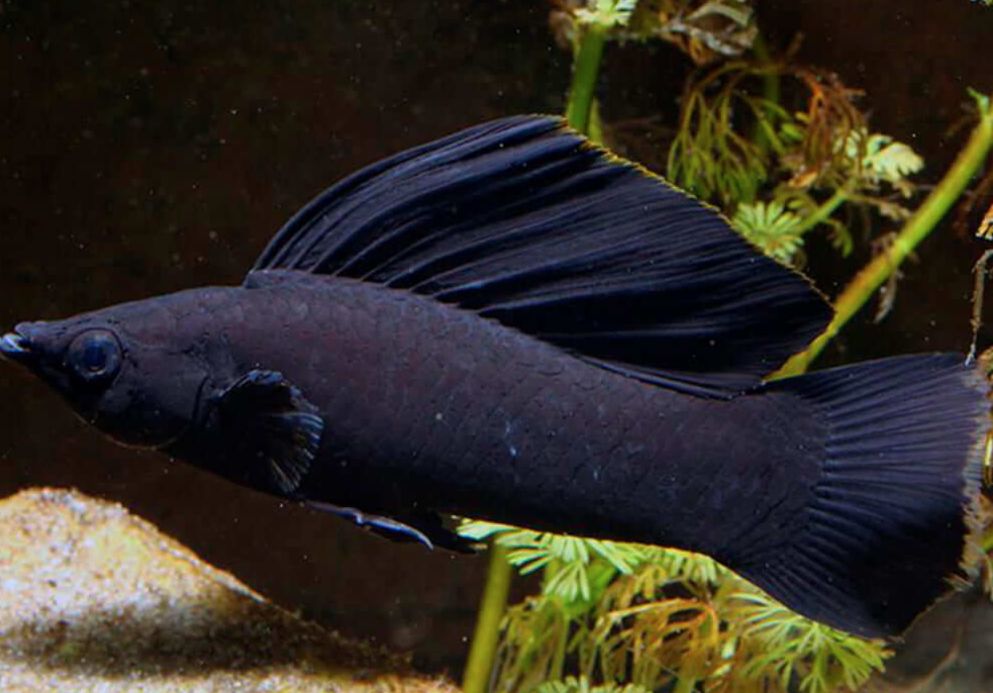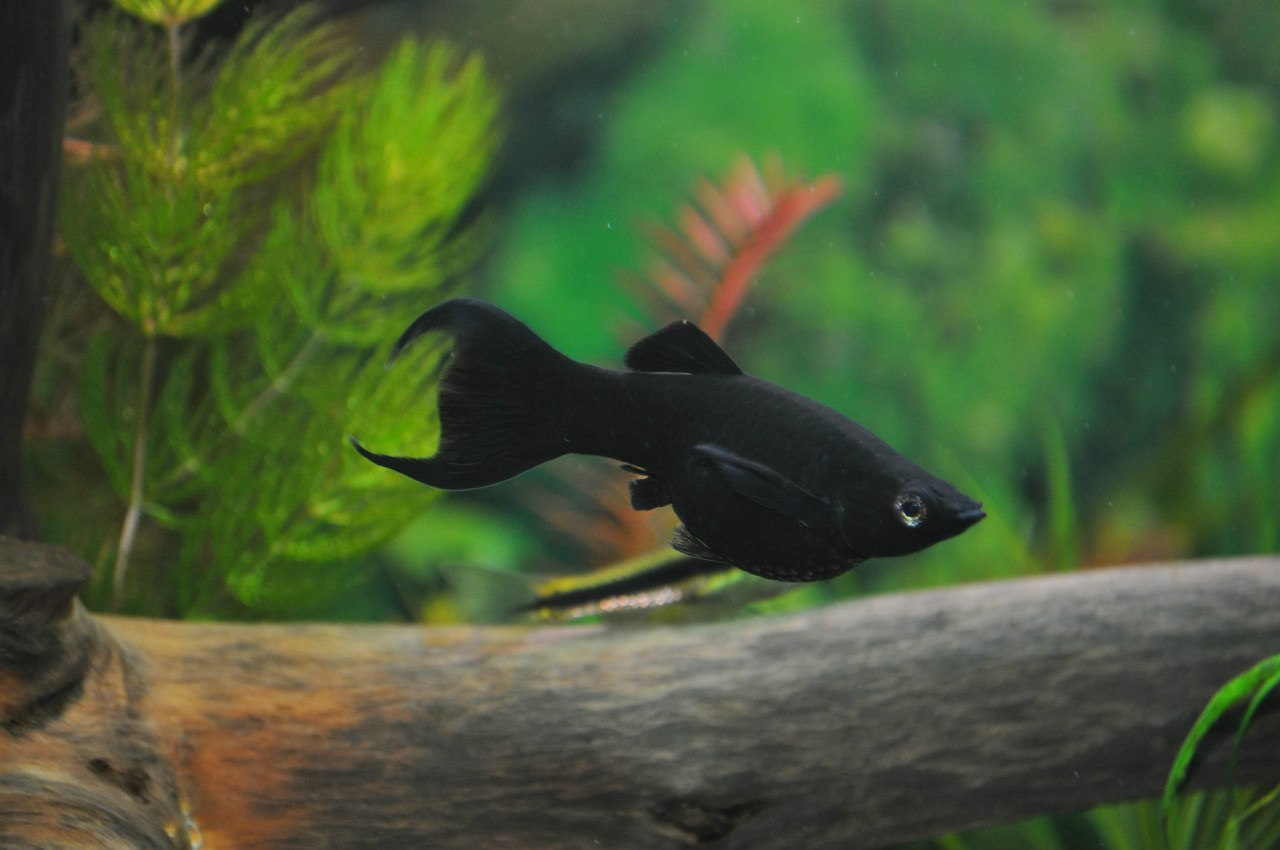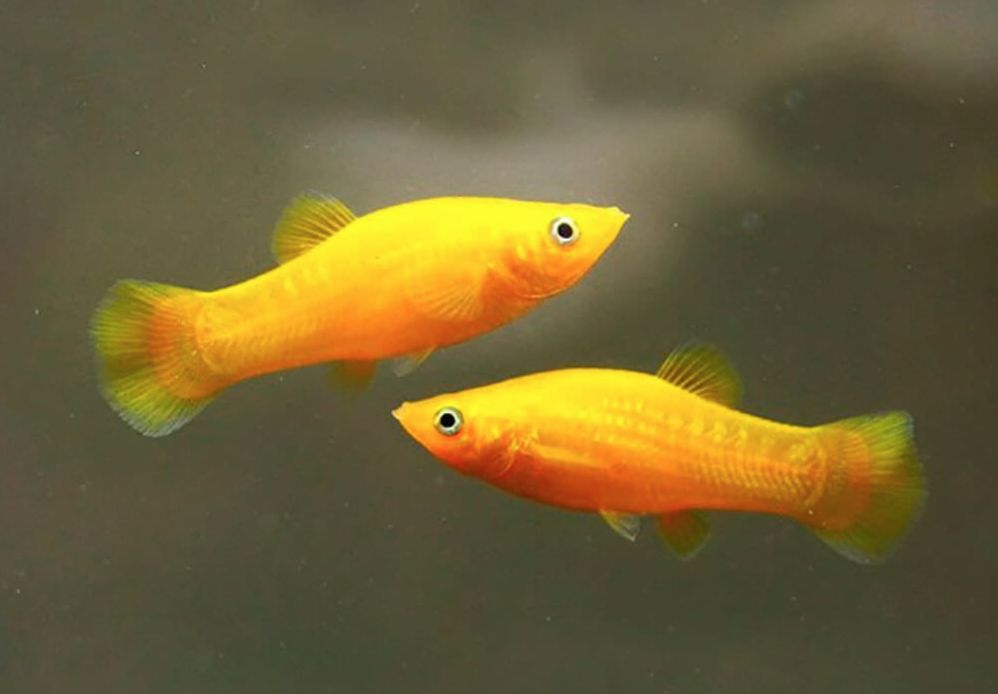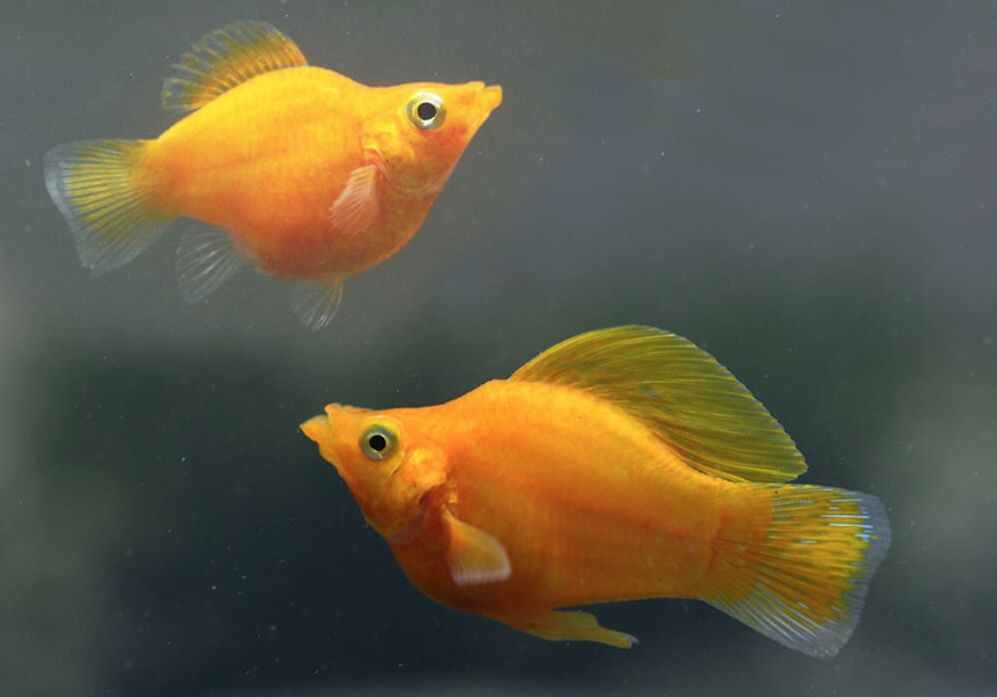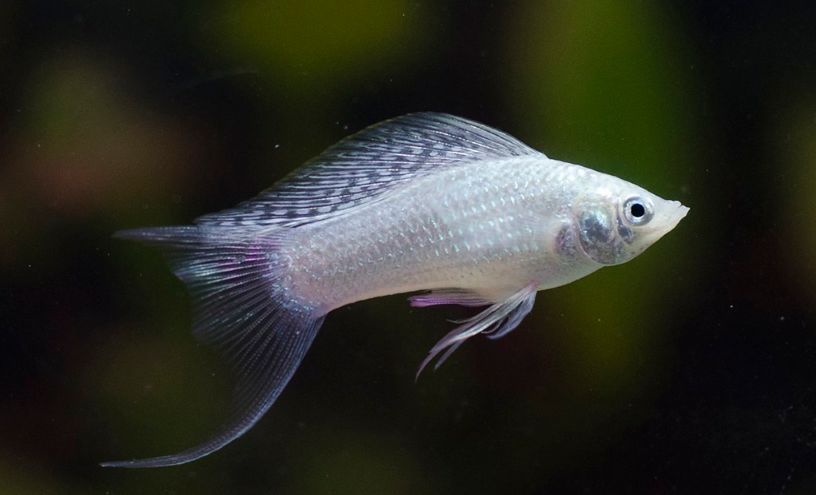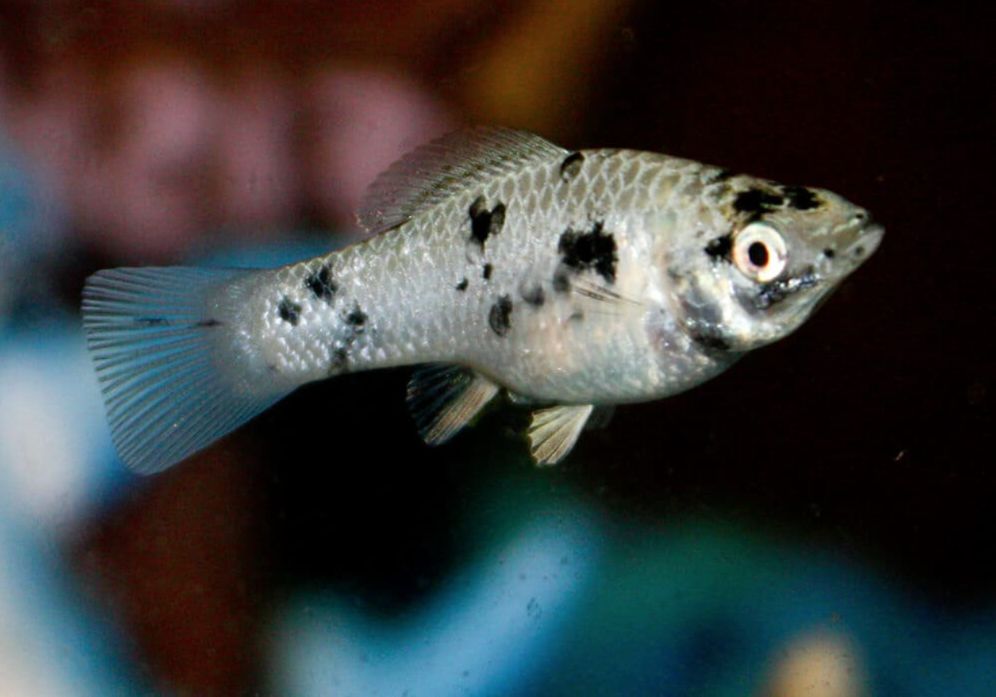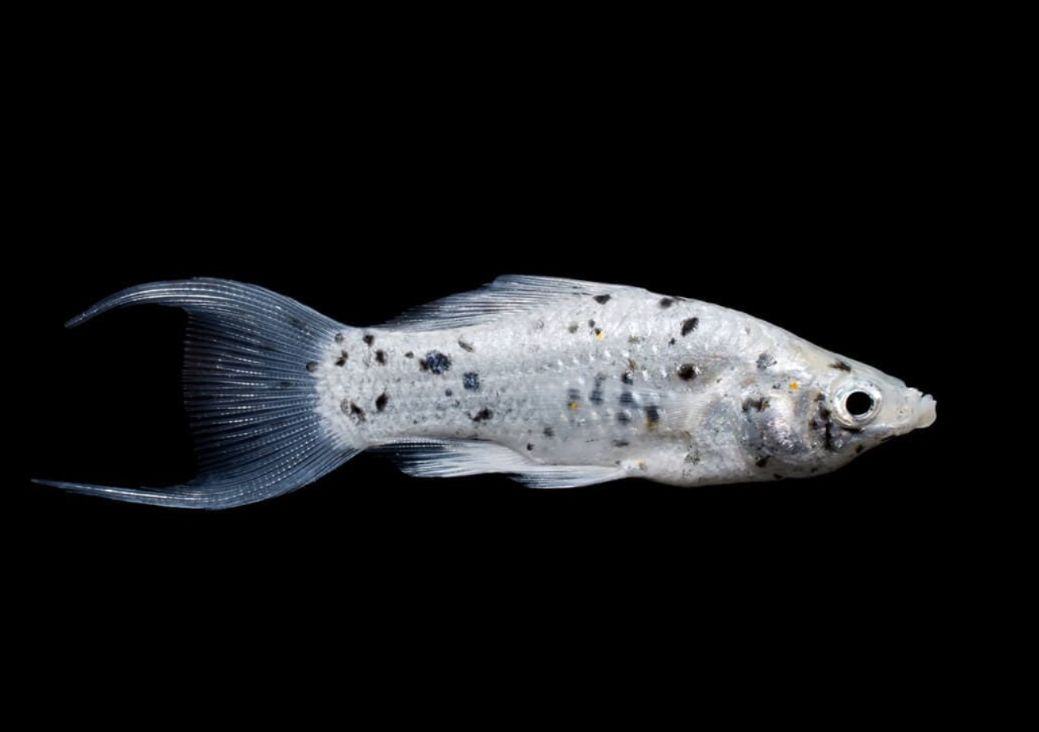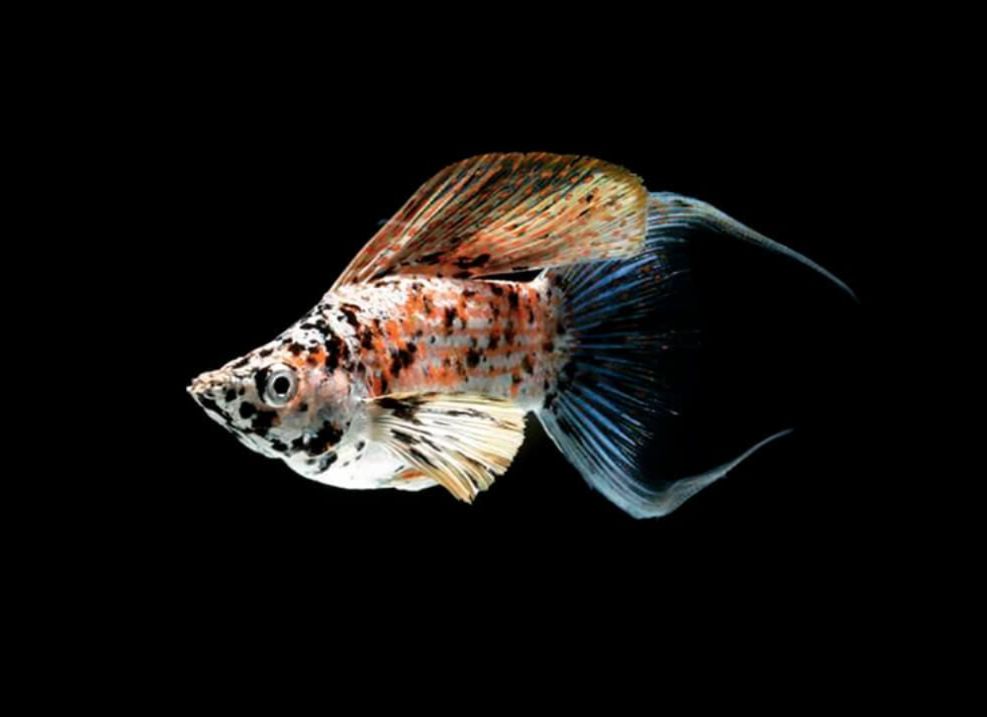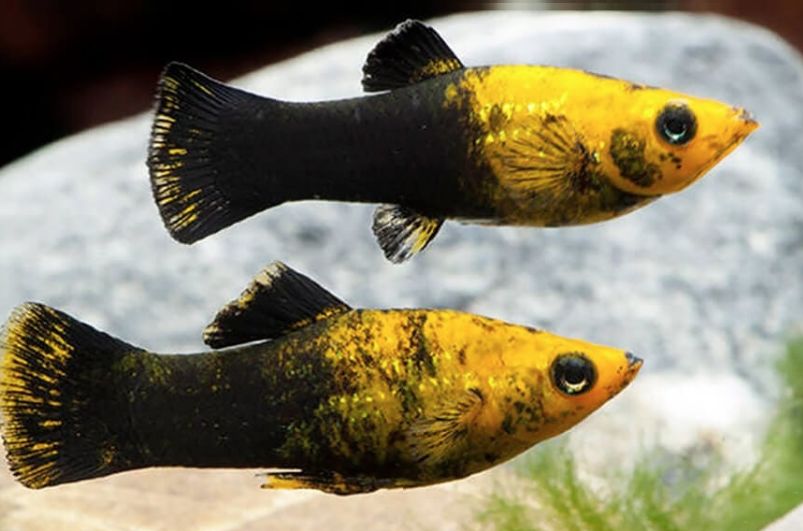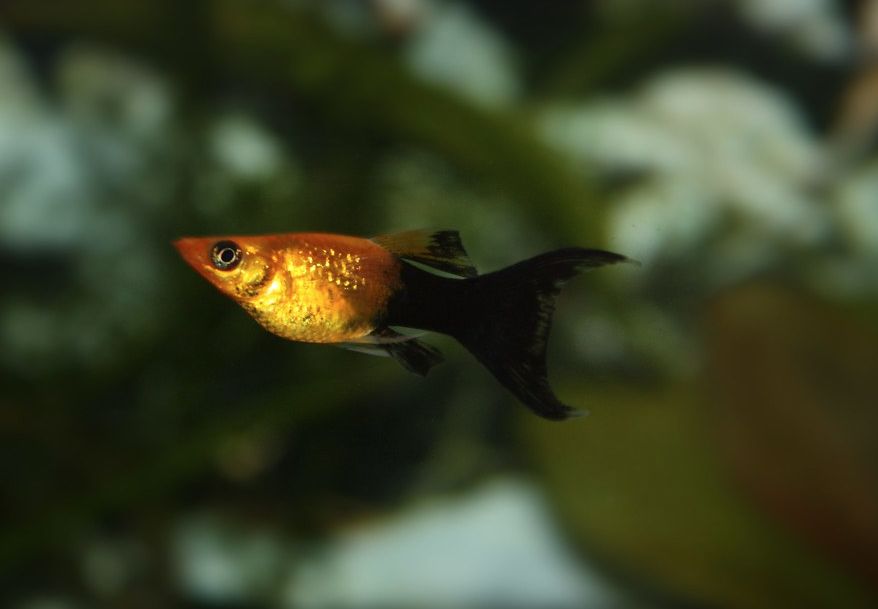Mollies are a small group of live-bearing fish from the Poecilia genus (previously included in the Mollienesia genus). They are widely popular among aquarists due to their hardy nature and ease of care, making them an excellent choice for beginners. Over the years, selective breeding has produced a wide range of molly varieties with distinct colors and body shapes, such as the black molly, sailfin molly, and balloon molly.
Despite the many different appearances, all mollies share common traits that make them highly desirable as aquarium pets. They are peaceful, hardy, inexpensive, and relatively easy to breed. Their peaceful temperament makes them compatible with many other community fish species.
The only notable differences between molly varieties are in size and coloration, but their care, breeding habits, and compatibility with other tank mates remain consistent across the species.

Contents
Difficulties in keeping
Molly fish are well-known for their peaceful nature, colorful appearance, and live-bearing reproductive system. They are a popular choice for community aquariums due to their ease of care and compatibility with other peaceful fish species. Molly fish come in various color variations, and their striking appearance makes them attractive to aquarium hobbyists.
The fishes are easy to care for and keep. They are a good choice for beginner aquarists. This is especially true for well-known and widespread black molly. You should be careful only with a balloon molly fish since, due to its curved shape, its lifespan is shorter than that of other molly species..
Size
The size of mollies can vary depending on the species and the conditions they are kept in. Understanding the typical size of mollies is essential for aquarists when selecting tank mates and ensuring a suitable aquarium setup. In general, mollies are considered small to medium-sized fish. Below are some common types of mollies and their average sizes:
- Common Molly (Poecilia sphenops): Common mollies typically grow to about 2.5 to 4 inches (6.5 to 10 cm) in length.
- Sailfin Molly (Poecilia latipinna): Sailfin mollies are slightly larger, reaching lengths of 4 to 5 inches (10 to 12.5 cm).
- Yucatan Molly (Poecilia velifera): The Yucatan molly is the largest of the molly species, growing up to 4 inches (10 cm) in home aquariums and up to 6 inches (15 cm) in the wild.
The size of mollies can also be influenced by factors such as diet, water quality, and tank size.
How long do molly fish live?
The lifespan of molly fish can vary based on several factors, including their species, genetics, water quality, diet, and overall care. Generally, molly fish have an average lifespan of about 2 to 5 years. This lifespan is influenced by their living environment and the temperature of the tank water; higher temperatures can accelerate their metabolism, leading to a shorter lifespan.
History
Molly fish belong to the Poeciliidae family, which is a family of freshwater fish found in Central and South America. The scientific name of the most commonly kept molly fish is Poecilia sphenops. The Poeciliidae family includes various other popular aquarium fish such as guppies (Poecilia reticulata), platies (Xiphophorus maculatus), and swordtails (Xiphophorus hellerii).
Poecilia sphenops have become the first described molly species. The description ws made by a French zoologist Achille Valenciennes in 1846 while working on his 22 books of “Histoire Naturelle des Poissons” (Natural History of Fish).
More than 50 years later, a renowned ichthyologist-classifier Charles Tate Regan described Poecilia salvatoris and Poecilia velifera basing on the sample study results in the British Natural History Museum.
In 1913 Poecilia latipinna was brought to Europe.
Since 1920 active work on selective breeding has started, and various hybrids appeared one after another. This was promoted by, first of all, the possibility of breeding between the three main molly kinds: Poecilia sphenops, Poecilia latipinna, and Poecilia velifera.
Habitat in the wild
Did you know that the molly genus (previously known as Mollienesia) was abolished, and all molly species are now part of the Poecilia genus? This was a surprising discovery for me while preparing this article! What’s more confusing is that many fish we commonly recognize as mollies are now included in this broader genus, adding to the complexity of their classification.
Mollies are incredibly adaptable fish, found in a wide range of habitats, from freshwater rivers and streams to brackish and saline waters. These environments vary in temperature, hardness, and acidity, and the various species within the Poecilia genus have evolved unique morphological traits to thrive in these different conditions. Interestingly, mollies were introduced to certain regions to help control mosquito populations, as they feed on mosquito larvae.
Wild molly species have a broad natural habitat, ranging from southern Texas in the north to the Caribbean coasts of Colombia and Venezuela in the south. This expansive range includes diverse environments, which has led to the development of many local forms of molly, each with its own distinct natural coloration influenced by its habitat.
Interestingly, mollies have been introduced to other parts of the world, where they have established populations in areas with similar conditions to their native habitats. Today, you can find these fish living and breeding in places like Singapore, Japan, and other regions across the globe.
Some specific species of interest include the sphenops molly, commonly found in the waters of Mexico and Colombia, and the sailfin molly, which inhabits brackish channels in states like Texas, Virginia, and Florida. Another notable species is the Yucatan molly, which is native to the Yucatan Peninsula in Mexico.
Keeping in a tank
Tank size
The tank size for molly fish depends on the specific type of molly, the number of fish you plan to keep, and whether you want to include other fish species in the aquarium. Generally, molly fish are active swimmers and can grow to around 2.5 to 4 inches (6.5 to 10 cm) in length, so they require adequate space to thrive.
In my opinion minimum tank size for the successful keeping of a small group of molly fish (3 to 5 individuals) is about 20 gallons (75 liters). This provides enough swimming space and allows you to maintain stable water conditions.
But these are active fishes. A 30-gallon (113 liters) or 40-gallon (150 liters) tank would be more suitable in such cases. Don’t keep the fish in small and crowded tanks. They may grow to become 10 cm long and will not feel comfortable in a small volume tank.
It’s important to remember that a larger tank usually means better water quality and more stable conditions, which can lead to healthier and happier fish. Overcrowding can cause stress and lead to health issues, so it’s best to avoid keeping molly fish in tanks that are too small for their needs.
For yucatan molly, it’s better to select a twice larger tank since they are significantly larger than their relatives. They like swimming a lot, and for this reason, it is recommended to get a tank of classical rectangular shape with a lid: molly often jumps out from the water.
Water parameters
Mollies are hardy fish known for their adaptability to various water parameters. However, creating optimal conditions in the aquarium is crucial for their growth and longevity. Maintaining a stable biotic balance is essential for their health. Here are the recommended water parameters for molly fish:
- Temperature: 72°F to 82°F (22°C to 28°C)
Mollies prefer warm water and do not tolerate rapid temperature changes well. - pH Level: 7.5 to 8.5
Mollies thrive in slightly alkaline water. Keeping the pH within this range supports their overall health. - Ammonia (NH3/NH4+): 0 ppm
Ammonia is toxic to fish, so it’s crucial to maintain levels at 0 ppm to prevent harm. - Nitrite (NO2-): 0 ppm
Like ammonia, nitrite is harmful. Regular water changes and efficient filtration are necessary to keep nitrite levels at 0 ppm. - Nitrate (NO3-): Below 40 ppm
While less toxic than ammonia and nitrite, high nitrate levels can still be harmful. Regular water changes help control nitrate concentrations. - General Hardness (GH): 10 to 25 dGH
Mollies prefer moderately hard water, and maintaining GH within this range benefits their health. - Carbonate Hardness (KH): 10 to 25 dKH
Keeping KH within this range helps stabilize pH and prevent rapid fluctuations. - Water Renewal:
Like all fish, mollies prefer clean water. It’s recommended to perform weekly water changes, replacing about 25% of the tank volume. This helps reduce nitrogenous compounds such as ammonia, nitrites, and nitrates, ensuring a healthy environment for your mollies.
Water salinity
Molly fish are quite adaptable and can thrive in both freshwater and brackish water environments. Some resources even recommend adding a small amount of salt to the tank water to benefit their health. While adding salt can be beneficial for mollies, it’s important to consider a few precautions.
Adding aquarium salt can help improve gill function, enhance osmoregulation, and reduce stress in molly fish. Salt assists in preventing infections and may promote overall health. However, mollies typically prefer to live in community tanks, and not all fish can tolerate brackish water. Other tank mates may not withstand the salinity levels, which could lead to stress or toxicity for them. Therefore, it is advisable to add salt only if molly fish are kept alone or when they are in quarantine.
If you decide to introduce salt, ensure that it is suitable for aquarium use, such as aquarium salt or marine salt. A common recommendation is to start with a small amount—generally about 1 tablespoon per 5 gallons of water—while monitoring your fish for any signs of distress. Gradual introduction is key to avoiding shock.
Salt helps molly fish regulate their internal body fluids, which is particularly beneficial in varying water conditions. This process is vital for their overall health and stability. When molly fish are placed in quarantine, adding salt can help prevent the onset of stress-related diseases, acting as a preventive measure during their adjustment period.
While mollies can tolerate low salinity, it’s essential not to over-salt the tank, as this can lead to long-term health issues for sensitive species. A careful balance is crucial for maintaining a healthy aquatic environment. If you are transitioning mollies from freshwater to brackish water, do so gradually to minimize stress and allow them to acclimate effectively. A slow acclimation process helps prevent shock and ensures a smooth transition.
Filtration and aeration
Water filtration and aeration are vital for maintaining a healthy and clean environment for molly fish in the aquarium. Proper filtration effectively removes waste, toxins, and impurities, ensuring water quality remains suitable for the well-being of the fish.
When selecting a filter for a molly tank, consider the tank size, the number of fish, and their waste production levels. A filter that can handle at least 4 to 6 times the tank volume per hour is recommended for optimal water quality. Suitable filter types include sponge filters, canister filters, and hang-on-back filters, each offering different benefits depending on your setup.
Regular filter maintenance is essential for optimal performance. This includes cleaning or replacing filter media, rinsing off debris, and regularly monitoring water parameters such as ammonia, nitrite, and nitrate levels.
Remember, molly fish produce more waste than some other species, so investing in a good filtration system will help maintain a clean and healthy aquarium environment for your fish.
Additionally, aeration increases oxygen levels in the water, which is particularly important for active swimmers like mollies. It’s crucial to cycle the tank before introducing mollies to establish beneficial bacteria that break down harmful waste products, ensuring a stable environment. In community tanks, be mindful of the compatibility of the filtration system with other species, as some may prefer calmer water conditions.
Plants and decorations
Mollies thrive in aquariums with specific tank conditions that mimic their natural habitat. They primarily inhabit the upper and middle water layers, so it’s essential to create open and well-lit areas in the tank. The aquarium should include snags, stones, and plenty of plants to provide shelter and enrichment for the fish.
Black mollies are particularly beneficial in planted tanks, as they help keep the leaves clean by grazing on algae without damaging the plants. A well-maintained environment with live plants contributes positively to their well-being.
It is advisable to organize some densely planted areas in the tank while ensuring that there is ample free space for mollies to swim freely.
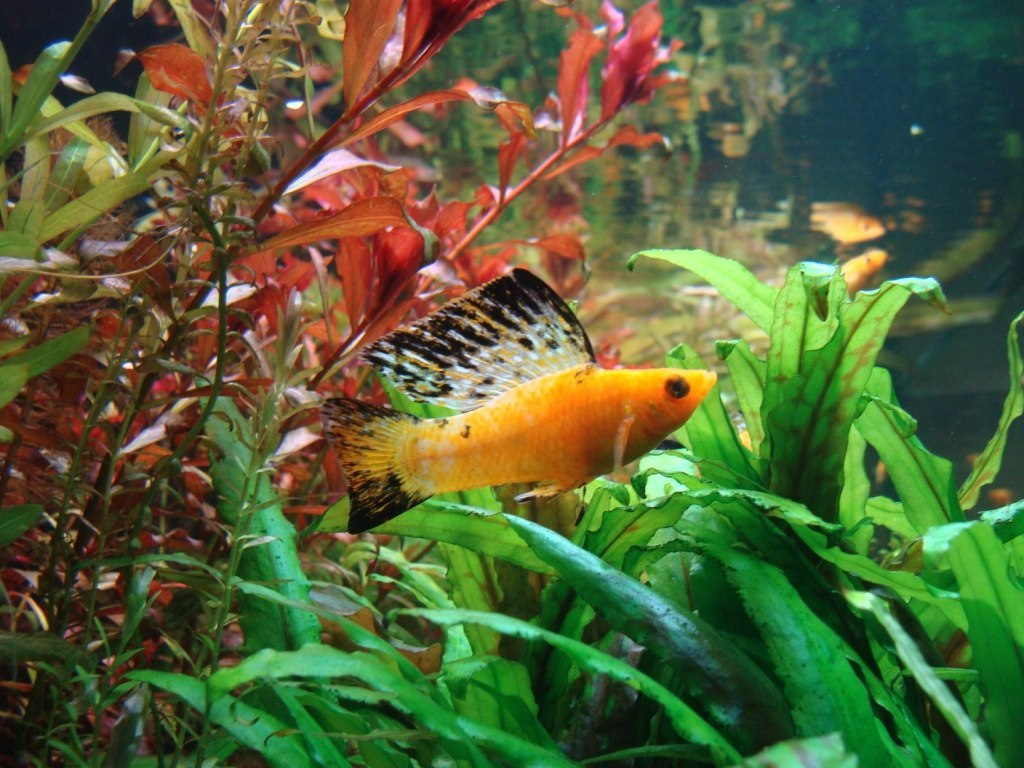
Tank mates
Molly fish is a very active one, and it is considered a peaceful one, though I’d rather say that it is a moderately aggressive one. Yes, in a roomy tank, it behaves very peaceful and calmly, but if the tank is small and crowded, the fish can show aggression towards its kind and sometimes to other fishes in the tank.
It’s better to keep back molly fish in a group where females prevail. This is a common rule for all live-breeders since when the number of males is equal to or higher than that of the female fish, the latter will always be stressed due to the males haunting them all the time.
The fish can live both in a common tank and separately. It gets on well with various tank mates. In general, tank mates have to be approximate of a similar size. Molly fish have good relationships within their group – they almost don’t show any intraspecific aggression. But at the same time, if the tank is small, the males may haunt each other. That’s why it’s better to have a spacious tank so that at least 2 gallons (10 liters) of water would fall for one fish.
When selecting tank mates, let them be of a similar size. Mollies get on well with other live-bearing fishes such as (guppy, Endler’s guppy, platy, swordtail), characins (black neon tetra, cardinal tetra, ember tetra, flame tetra, neon tetra), rasboras (harlequin rasbora), danios (zebrafish), corydoras (Corydoras julii, panda cory, pygmy cory, Adolfo’s catfish), plecos (bristlenose pleco). They can live together with barbs (tiger barb, cherry barb, Odessa barb, rosy barb); Poecilia velifera is the only exception – the males’ long fins may be nipped in this case.
When keeping mollies with other fishes, the tank should be spacious, and it should have enough shelters. It’s not recommended to keep even large molly species with aggressive cichlids (like Jack Dempsey fish, jaguar cichlid, texas cichlid, flowerhorn).
If you want all mollies in the tank to have the same appearance, don’t keep different fish kinds together in the tank to avoid cross-breeding.
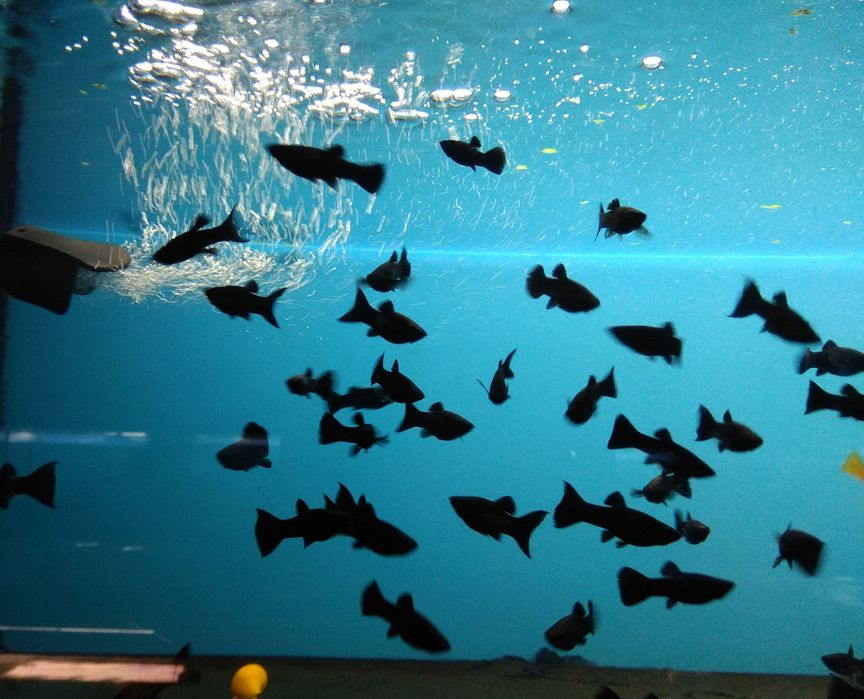
Diet
Mollies are omnivorous fish, meaning they eat a wide variety of foods, including live, frozen, and artificial options. However, a crucial part of their diet is food rich in vegetable fibers, such as algae and vegetables. In the wild, mollies consume a significant amount of algae, which is reflected in their natural behavior. You’ll often notice them grazing on algae or scraping growth off tank glass and decorations. In fact, in their natural habitat, mollies help control algae growth, making them a beneficial addition to planted tanks.
For aquarium feeding, it’s important to provide molly-specific flakes or pellets with vegetable components. You can also supplement their diet with boiled vegetables like cucumbers, zucchini, or lettuce leaves. As for live food, bloodworms, tubifex, and brine shrimp are great additions but should be fed in moderation. Overfeeding mollies, especially with protein-rich foods like bloodworms, can lead to health issues such as bloating or fatty liver disease, so balancing their diet with plant-based food is essential.
Feeding mollies with high-quality artificial food is often the best choice, as it is well-balanced, rich in essential vitamins, and easy for them to digest. Additionally, it’s convenient to store and serve, making it a practical option for aquarists.
Feed your mollies several times a day, ensuring that each portion can be consumed within a few minutes. Be cautious not to overfeed, as mollies are prone to overeating. Smaller portions are preferable to keep your fish healthy and prevent digestive issues. Offering a variety of foods that mimic their natural diet also helps maintain their vibrant coloration, particularly in brightly colored molly varieties.
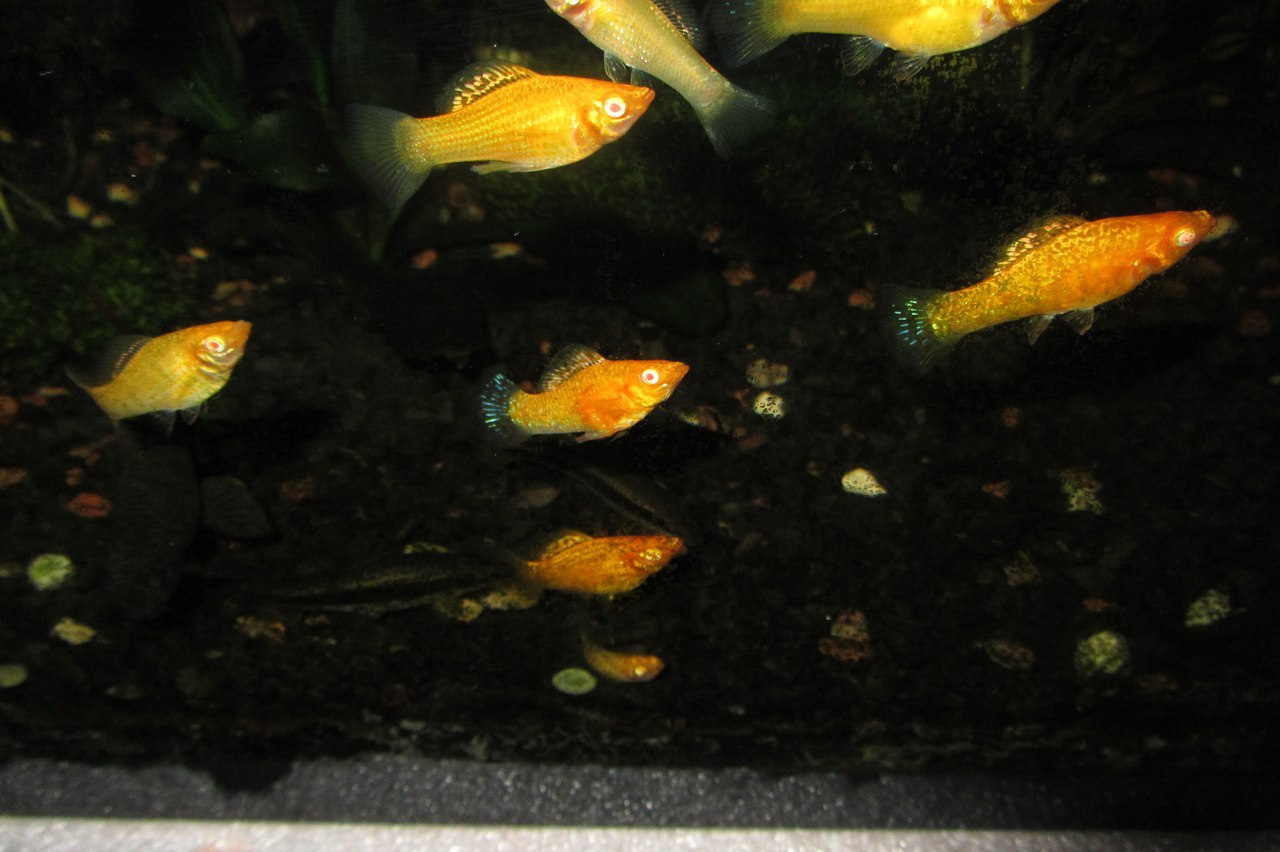
Gender differences: male vs female
Identifying male and female molly fish is relatively straightforward, thanks to several distinct physical and behavioral traits. Knowing the differences between males and females can be particularly useful for aquarists who want to manage breeding or maintain a balanced tank.
Here are some of the key characteristics that can help you distinguish between male and female mollies:
- Size: Generally, male molly fish are slightly smaller than females. Females tend to be larger and more robust, especially when they are pregnant with fry (baby fish).
- Fin Shape: One of the most noticeable differences is the shape of their anal fin, located on the underside of the fish near the tail. Male mollies have a modified anal fin called a “gonopodium,” which is elongated and pointed. The gonopodium is used for mating and is absent in females, who have a rounded, fan-shaped anal fin.
- Pregnancy: Female molly fish often have a prominent gravid spot near their anal fin. This darkened spot becomes more noticeable as the female carries developing fry. Since mollies are livebearers, females give birth to live, fully-formed fry rather than laying eggs. Female mollies can also store sperm from males and give birth multiple times from a single mating, which allows them to have several broods without needing to mate again.
- Behavior: Male mollies are typically more active and may display aggressive behavior, especially during mating or when competing for the attention of females. They are often seen chasing females and other males during courtship. Male mollies’ more vibrant coloration can intensify during this time, serving as a visual cue for females.
- Body Shape: Females usually have a rounder abdomen, especially when carrying fry. Males, in contrast, tend to have a more streamlined body.
- Coloration: While color differences are not always a reliable indicator of sex, in some species and varieties of mollies, males may have more vibrant and colorful markings than females, especially during mating season. This vibrant coloration can be a helpful visual clue for identifying males.
Recognizing these differences is essential for aquarists, particularly those looking to breed mollies or manage population control in community tanks. Being able to identify a gravid female can also help predict when she is about to give birth, allowing aquarists to separate her to protect the fry from being eaten.
Breeding
Molly fish are livebearers, much like guppies, meaning their juveniles are born fully formed, skipping the egg stage. Breeding mollies requires no special conditions—simply keeping males and females together in a community tank is usually enough to encourage spawning. However, for better control and to protect the fry, a separate spawning tank is often recommended.
When kept in comfortable conditions, molly fish will spawn roughly once a month. During mating, the male uses his gonopodium (a modified anal fin) to transfer sperm to the female, which increases the chances of successful fertilization. Males typically become reproductive at around 12 months, while females reach sexual maturity by 6 months.
Mollies can breed in both community tanks and separate spawning tanks, but using a spawning tank helps protect juveniles from being eaten by other fish, including their own parents. The female ready to give birth should be placed in a tank with a capacity of at least 5 liters. A larger tank can cause stress, so smaller, well-planted tanks are ideal. Plants and hiding spots provide shelter for the juveniles.
Female mollies carry the fertilized eggs for approximately 35 to 45 days. It can be challenging to tell if a female is pregnant, particularly in black molly varieties. Common signs of pregnancy include an enlarged abdomen and the female hiding in darker corners of the tank. It’s best to move a pregnant female to a separate spawning tank with water parameters similar to the main tank.
Spawning usually occurs in the early morning, and larger females may give birth to as many as 100 juveniles in one brood. The number of fry produced depends on the age and size of the female. Molly fry are relatively large at birth, and they may rest on the tank bottom or among plant leaves for a while before becoming active. However, they are extremely sensitive to water quality, so frequent water changes in their tank are essential to ensure healthy development.
To promote fast growth, juvenile mollies require a varied diet. You can feed them finely ground high-quality artificial food or specialized fry food. Ensuring a balanced diet will help the fry grow strong and healthy.
Molly fish types
There are four main species of molly fish found in the wild, each with unique characteristics that aquarists should be aware of for proper care and tank compatibility:
- Short-finned molly or common molly (Poecilia sphenops): This is the most widely recognized species, often seen in home aquariums. Common mollies are adaptable and can thrive in a variety of water conditions. They typically have a shorter fin structure compared to other species.
- Liberty molly (Poecilia salvatoris): Known for its vibrant coloration and lively behavior, the liberty molly is a favorite among aquarists. This species is often found in freshwater environments and prefers slightly warmer waters.
- Yucatan molly (Poecilia velifera): The largest of the molly species, the Yucatan molly can grow up to 6 inches (15 cm) in length. This species is native to the Yucatan Peninsula in Mexico and is recognized for its unique body shape and coloration.
- Sailfin molly (Poecilia latipinna): Characterized by its large, sail-like dorsal fin, the sailfin molly is popular for its striking appearance. This species prefers brackish waters and can be found in coastal areas, making it a great addition to community tanks that mimic similar conditions.
All other fish variations commonly referred to as mollies are cultivated forms derived from these species through selective breeding, resulting in various colors and fin shapes.
Molly Natural breeds
Common molly (Poecilia sphenops)
The black molly (Poecilia sphenops) is one of the most popular fish in the aquarium trade, derived from its wild counterpart. In natural habitats, wild mollies exhibit less vibrant colors compared to the striking black variations commonly found in home aquariums.
Wild mollies typically display a body that is greyish-green on the dorsal side with a subtle light-blue tint, while their ventral side can range from gray-white to silvery-blue. Scattered dark spots of varying intensities adorn their bodies, contributing to their unique appearance.
Poecilia sphenops have an elongated, solid, and laterally flattened body, culminating in a round, well-developed tail fin. Their fins are relatively small, and their mouths are adapted for grazing on food at the water’s surface and scraping algae. In terms of size, black mollies generally range from 2 to 4 inches (5 to 10 cm) in length, with females typically growing larger than males.
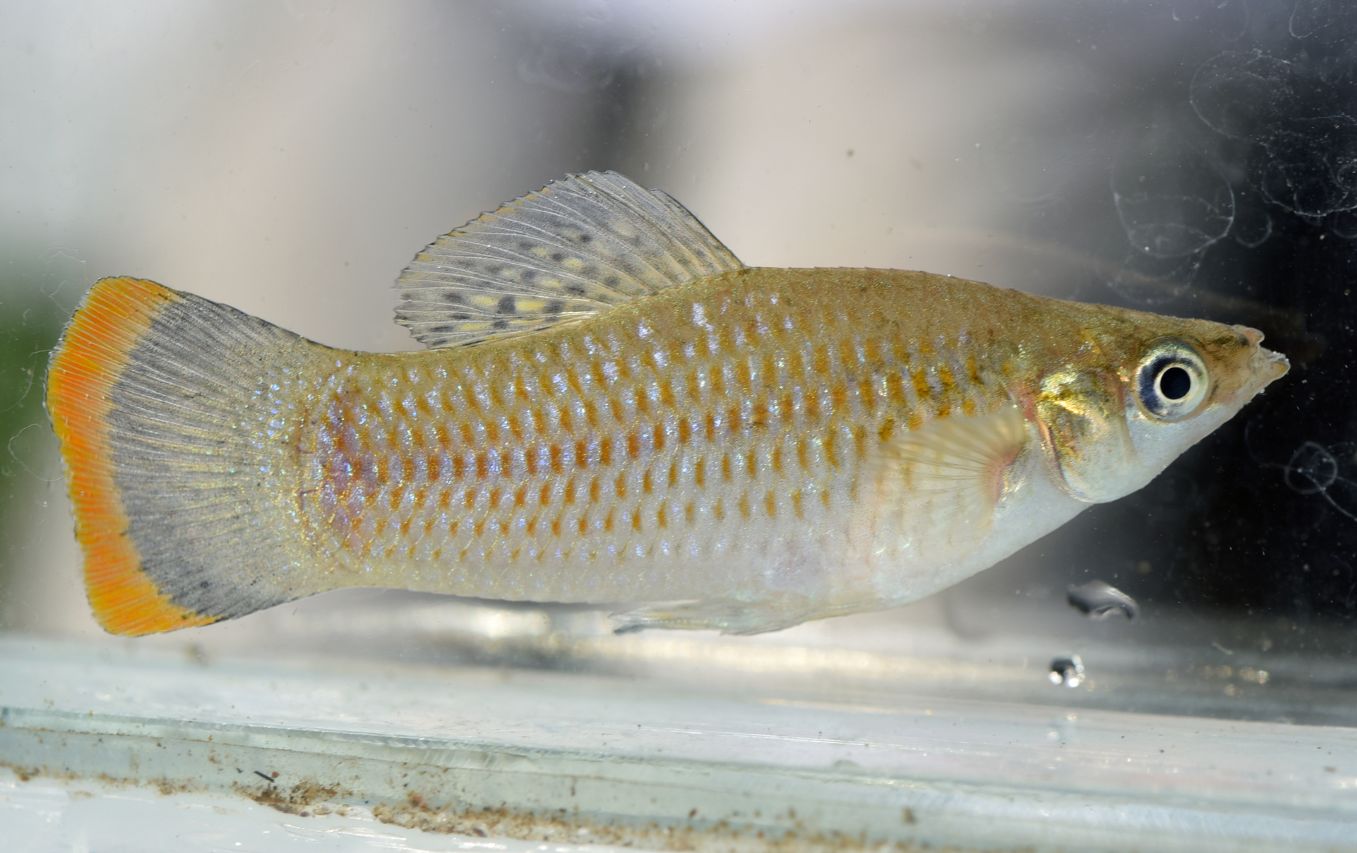
| Characteristic | Description |
|---|---|
| Scientific Name | Poecilia sphenops |
| Family | Poeciliidae |
| Origin | Central and South America |
| Size | 2.5 to 4 inches (6 to 10 cm) |
| Lifespan | 2 to 5 years |
| Colors | Various colors and patterns (black, white, orange) |
| Temperament | Peaceful and social |
| Aquarium Size | At least 10 gallons (38 liters) per fish |
| Water Parameters | Temperature: 72-82°F (22-28°C), pH: 7.0-8.5 |
| Diet | Omnivorous – flake/pellet food, live/frozen foods |
| Breeding | Livebearers – females give birth to live fry |
| Compatibility | Get along with other peaceful community fish |
| Tank Setup | Plenty of hiding spots and live plants |
| Care Level | Easy |
| Maintenance | Regular water changes and tank cleaning |
| Special Considerations | Sensitive to water quality, avoid aggressive tankmates |
Yucatan molly (Poecilia velifera)
A distinctive feature of the sailfin molly (Poecilia latipinna) is the well-developed dorsal fin found in males. This fin can reach up to 3 inches (7.5 cm) in length, dominating the fish’s back and making it a visually striking addition to any aquarium. The sailfin molly is the largest of the molly species, typically growing to about 10 cm (4 inches) in captivity, and can reach lengths of up to 15 cm (6 inches) in the wild. Its tail fin has a rounded shape, and its natural body color is silvery, adorned with horizontal dashed lines.
Due to its size and active nature, the sailfin molly requires spacious tanks to swim freely. When selecting tank mates, it’s crucial to choose compatible species, as some fish, like tiger barbs, may nip at the molly’s fins. Ideal companions for sailfin mollies include other peaceful community fish that won’t harass them.

| Characteristic | Description |
|---|---|
| Scientific Name | Poecilia velifera |
| Common Name | Yucatan Molly |
| Origin | Mexico, specifically the Yucatan Peninsula |
| Size | Typically 3 to 4 inches (7.5 to 10 cm) |
| Lifespan | 2 to 5 years |
| Temperament | Peaceful and social |
| Water Conditions | Freshwater with a temperature of 72-82°F (22-28°C) |
| Tank Size | Minimum 20 gallons (75 liters) for a small group |
| Diet | Omnivorous – eats flakes, pellets, and live foods |
| Tank Level | Middle and top of the aquarium |
| Gender Differences | Males are smaller and more colorful than females |
| Breeding | Livebearer – gives birth to live fry |
| Special Considerations | Prefers planted tanks with hiding spots |
Sailfin molly (Poecilia latipinna)
The liberty molly (Poecilia salvatoris) is quite similar to the yucatan molly but is generally smaller and features different coloration. This species has a tall, elongated, and laterally flattened body. The dorsal fin is high and rectangular, consisting of 12 to 14 rays, while the tail fin is round and well-developed.
In the wild, males can reach sizes of up to 5 inches (12 cm); however, they typically grow to about 3 inches (7.5 cm), while mature females generally reach sizes of around 2.5 inches (6.5 cm). The overall coloration of liberty mollies is bluish-grey. Males exhibit a green-blue tint adorned with sparkling white spots arranged in rows along their sides, and their ventral surface is bright orange. The fins display a striking blue color with orange edges, along with colorful spots and dashes.

| Characteristic | Description |
|---|---|
| Scientific Name | Poecilia latipinna |
| Common Name | Sailfin Molly |
| Family | Poeciliidae |
| Origin | Coastal regions of North, Central, and South America |
| Size | Up to 4 inches (10 cm) |
| Lifespan | 2 to 5 years |
| Colors | Various colors, including black, white, orange, yellow, and silver |
| Body Shape | Elongated and laterally compressed |
| Dorsal Fin | Large, sail-like dorsal fin |
| Behavior | Peaceful and social |
| Water Conditions | Tropical freshwater |
| Temperature Range | 72°F to 82°F (22°C to 28°C) |
| pH Range | 7.0 to 8.5 |
| Tank Size | Minimum 20 gallons for a small group |
| Diet | Omnivorous – eats both plants and small insects |
| Feeding | Flakes, pellets, and small live/frozen foods |
| Compatibility | Generally peaceful, but avoid aggressive tankmates |
| Breeding | Livebearer – gives birth to live fry |
| Special Considerations | Males have more prominent fins than females |
Liberty molly (Poecilia salvatoris)
Poecilia salvatoris, once considered a variation of Poecilia sphenops, is now recognized as a distinct species. This fish inhabits the waters of El Salvador and is rarely found in aquariums, despite its appealing coloration. One reason for its scarcity in the aquarium trade is its aggressive temperament, as it tends to attack both its own kind and other tank inhabitants.
The body of the liberty molly is silvery-yellow, sometimes exhibiting a light-blue tint. Its abdomen and dorsal fins are particularly striking, displaying bright colors that can include red, black, or white.
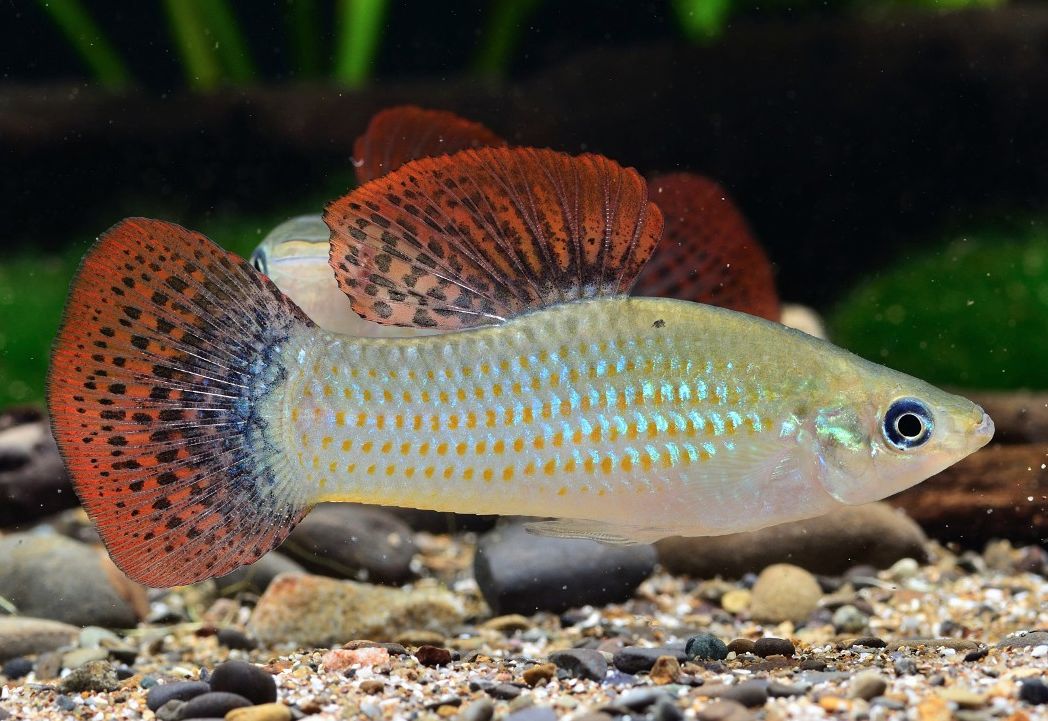
Molly selective breeds
Selectionists constantly strive to create more and more new color variations of tank fish. They even conduct genetic experiments (for example, glofish). The same has happened to molly since this is a live-bearing fish which offspring is easy to get.

